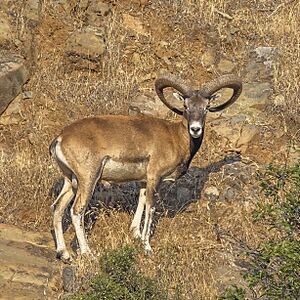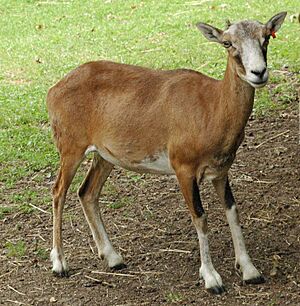Mouflon facts for kids
Quick facts for kids Mouflon |
|
|---|---|
 |
|
| A male Cyprus mouflon, a type of wild sheep. | |
| Conservation status | |
| Scientific classification | |
 |
|
| Where the Ovis gmelini lives. |
The mouflon (Ovis gmelini) is a type of wild sheep. It lives in the Caspian region, which includes parts of Turkey, Armenia, Azerbaijan, Georgia, and Iran. You can also find mouflons in Europe. Scientists believe the mouflon is the ancestor of all modern domestic sheep breeds we have today.
Contents
Types of Mouflon
The scientific name for the mouflon is Ovis gmelini. This name was first used by Edward Blyth in 1841. There are different kinds of mouflons, which scientists call subspecies. These are like different groups within the same animal family.
Here are some of the main mouflon subspecies:
- Armenian mouflon (or Armenian red sheep), O. g. gmelini: This type lives in northwestern Iran, Armenia, and Azerbaijan. Some have also been brought to Texas in the U.S.
- Esfahan mouflon, O. g. isphahanica: You can find these in the Zagros Mountains in Iran.
- Laristan mouflon, O. g. laristanica: This is a smaller type of mouflon. It lives in special desert areas near Lar in southern Iran.
- Cyprus mouflon, O. g. ophion: This type is also called agrino. It almost disappeared in the 20th century. But thanks to conservation efforts, their numbers have grown. In 1997, there were about 1,200, and by 2012, there were around 3,000 on Cyprus.
The European mouflon was once thought to be a subspecies of the mouflon. However, scientists now believe it is a wild descendant of domestic sheep.
What Mouflons Look Like
Mouflons have coats that are reddish to dark brown. Their fur is short. They have dark stripes on their backs. Their bellies are black, and they have light-colored patches on their sides.
Male mouflons, called rams, have horns. Some female mouflons, called ewes, also have horns, while others do not. The horns of adult rams can curve almost in a full circle. They can be as long as 85 centimeters (about 33 inches).
Mouflons are about 0.9 meters (3 feet) tall at the shoulder. Males usually weigh around 50 kilograms (110 pounds). Females are a bit lighter, weighing about 35 kilograms (77 pounds).
Where Mouflons Live
Mouflons live in the Lesser Caucasus region. This area includes southeastern Turkey, Armenia, and Azerbaijan. They also live in Iran's western Alborz region and the Zagros Mountains. These mountains stretch across eastern Iraq and western Iran. It is thought that mouflons might have been brought to Cyprus a very long time ago, during the Neolithic period.
Reproduction and Life Cycle
Mouflon rams have a strict social order. Before the mating season, which is from late autumn to early winter, rams try to show who is strongest. This helps them decide which males get to mate with the ewes. Rams will fight each other to become dominant.
Mouflons become old enough to have babies when they are 2 to 4 years old. Young rams need to become dominant before they can mate. This can take another 3 years for them to start breeding. Female mouflons also have a social order, but they can breed even if they are not at the top.
A female mouflon is pregnant for about 5 months. She usually gives birth to one or two babies.
In 2001, scientists successfully cloned a mouflon. This means they made an exact copy of an animal. The cloned mouflon lived for at least seven months. This was important because it showed that a common animal, like a domestic sheep, could help give birth to an endangered animal like the mouflon. This technology could help protect endangered species in the future.
Conservation Efforts
Mouflons are protected in Armenia and Azerbaijan. In Turkey and Iran, people can only hunt them with a special license. The mouflon population in Cyprus is very important. It is listed as a strictly protected species by the European Union. It has also been listed in CITES Appendix I since 2019. This means it is highly protected from international trade.
Mouflons in Culture
Mouflons are important in the culture of some places.
- In Corsica, a male mouflon is called Mufro, and a female is called Mufra.
- The mouflon was the logo for Cyprus Airways until 2015.
- You can see the mouflon on the 1-, 2-, and 5-cent Cypriot euro coins.
- A mouflon is shown on the old flag of the Armenian kingdom of Syunik. You can also see them on old tombstones there.
- The mouflon is the symbol and nickname for the Cyprus national rugby union team.
- It is also the official mascot for Craghoppers, a company that makes outdoor clothing in the UK.
See also



